Spatio-Temporal Change and Pollution Risk of Agricultural Soil Cadmium in a Rapidly Industrializing Area in the Yangtze Delta Region of China
Abstract
1. Introduction
2. Materials and Methods
2.1. Study Area
2.2. Soil Sampling and Chemical Analysis
2.3. Mapping the Spatio-Temporal Changes and Potential Risk of Cd Pollution
3. Results
3.1. Descriptive Statistics and Spatial Variability of Cd
3.2. Spatio-Temporal Patterns of Changes in Cd
3.3. Potential Risk of Soil Cd Pollution
4. Discussion
5. Conclusions
Author Contributions
Funding
Conflicts of Interest
References
- Bowen, H.J.M. Environmental Chemistry of the Elements; Academic Press: London, UK; New York, NY, USA, 1979; pp. 123–125. [Google Scholar]
- Gramlich, A.; Tandy, S.; Gauggel, C.; Lopez, M.; Perla, D.; Gonzalez, V.; Schulin, R. Soil cadmium uptake by cocoa in Honduras. Sci. Total Environ. 2018, 612, 370–378. [Google Scholar] [CrossRef]
- Birke, M.; Reimann, C.; Rauch, U.; Ladenberger, A.; Demetriades, A.; Jahne-Klingberg, F.; Oorts, K.; Gosar, M.; Dinelli, E.; Halamic, J.; et al. GEMAS: Cadmium distribution and its sources in agricultural and grazing land soil of Europe—Original data versus clr-transformed data. J. Geochem. Explor. 2017, 173, 13–30. [Google Scholar] [CrossRef]
- Zhang, H.H.; Chen, J.J.; Zhu, L.; Li, F.B.; Wu, Z.F.; Yu, W.M.; Liu, J.M. Spatial patterns and variation of soil cadmium in Guangdong Province, China. J. Geochem. Explor. 2011, 109, 86–91. [Google Scholar] [CrossRef]
- Cheng, S.W.; Liu, G.J.; Zhou, C.C.; Sun, R.Y. Chemical speciation and risk assessment of cadmium in soils around a typical coal mining area of China. Ecotoxicol. Environ. Saf. 2018, 160, 67–74. [Google Scholar] [CrossRef] [PubMed]
- Shao, D.W.; Zhan, Y.; Zhou, W.J.; Zhu, L.Z. Current status and temporal trend of heavy metals in farmland soil of the Yangtze River Delta Region: Field survey and meta-analysis. Environ. Pollut. 2016, 219, 329–336. [Google Scholar] [CrossRef] [PubMed]
- Bigalke, M.; Ulrich, A.; Rehmus, A.; Keller, A. Accumulation of cadmium and uranium in arable soils in Switzerland. Environ. Pollut. 2017, 221, 85–93. [Google Scholar] [CrossRef]
- Stafford, A.D.; Palmer, A.S.; Jeyakumar, P.; Hedley, M.J.; Anderson, C.W.N. Soil cadmium and New Zealand dairy farms: Impact of whole-farm contaminant variability on environmental management. Agric. Ecosyst. Environ. 2018, 254, 282–291. [Google Scholar] [CrossRef]
- Wang, M.E.; Liu, R.; Chen, W.P.; Peng, C.; Markert, B. Effects of urbanization on heavy metal accumulation in surface soils, Beijing. J. Environ. Sci.-China 2018, 64, 328–334. [Google Scholar] [CrossRef]
- Xia, X.H.; Chen, X.; Liu, R.M.; Liu, H. Heavy metals in urban soils with various types of land use in Beijing, China. J. Hazard. Mater. 2011, 186, 2043–2050. [Google Scholar] [CrossRef]
- China Ministry of Environmental Protection; China Ministry of Land and Resources. National Soil Pollution Survey Report. Available online: http://www.zhb.gov.cn/gkml/hbb/qt/201404/t20140417_270670.htm (accessed on 8 June 2018).
- Ai, S.W.; Liu, B.L.; Yang, Y.; Ding, J.; Yang, W.Z.; Bai, X.J.; Naeem, S.; Zhang, Y.M. Temporal variations and spatial distributions of heavy metals in a wastewater-irrigated soil-eggplant system and associated influencing factors. Ecotoxicol. Environ. Saf. 2018, 153, 204–214. [Google Scholar] [CrossRef]
- Xue, S.G.; Shi, L.Z.; Wu, C.; Wu, H.; Qin, Y.Y.; Pan, W.S.; Hartley, W.; Cui, M.Q. Cadmium, lead, and arsenic contamination in paddy soils of a mining area and their exposure effects on human HEPG2 and keratinocyte cell-lines. Environ. Res. 2017, 156, 23–30. [Google Scholar] [CrossRef]
- Ran, J.; Wang, D.J.; Wang, C.; Zhang, G.; Zhang, H.L. Heavy metal contents, distribution, and prediction in a regional soil-wheat system. Sci. Total Environ. 2016, 544, 422–431. [Google Scholar] [CrossRef] [PubMed]
- Cao, S.S.; Lu, A.X.; Wang, J.H.; Huo, L.L. Modeling and mapping of cadmium in soils based on qualitative and quantitative auxiliary variables in a cadmium contaminated area. Sci. Total Environ. 2017, 580, 430–439. [Google Scholar] [CrossRef]
- Niu, L.L.; Yang, F.X.; Xu, C.; Yang, H.Y.; Liu, W.P. Status of metal accumulation in farmland soils across China: From distribution to risk assessment. Environ. Pollut. 2013, 176, 55–62. [Google Scholar] [CrossRef] [PubMed]
- Zhao, K.L.; Liu, X.M.; Xu, J.M.; Selim, H.M. Heavy metal contaminations in a soil-rice system: Identification of spatial dependence in relation to soil properties of paddy fields. J. Hazard. Mater. 2010, 181, 778–787. [Google Scholar] [CrossRef] [PubMed]
- Yang, P.G.; Mao, R.Z.; Shao, H.B.; Gao, Y.F. An investigation on the distribution of eight hazardous heavy metals in the suburban farmland of China. J. Hazard. Mater. 2009, 167, 1246–1251. [Google Scholar] [CrossRef] [PubMed]
- Li, P.; Zhi, Y.Y.; Shi, J.C.; Zeng, L.Z.; Wu, L.S. County-scale temporal-spatial distribution and variability tendency of heavy metals in arable soils influenced by policy adjustment during the last decade: A case study of Changxing, China. Environ. Sci. Pollut. Res. 2015, 22, 17937–17947. [Google Scholar] [CrossRef] [PubMed]
- Chen, H.Y.; Yuan, X.Y.; Li, T.Y.; Hu, S.; Ji, J.F.; Wang, C. Characteristics of heavy metal transfer and their influencing factors in different soil-crop systems of the industrialization region, China. Ecotoxicol. Environ. Saf. 2016, 126, 193–201. [Google Scholar] [CrossRef] [PubMed]
- Huang, B.; Shi, X.Z.; Yu, D.S.; Oborn, I.; Blomback, K.; Pagella, T.F.; Wang, H.J.; Sun, W.X.; Sinclair, F.L. Environmental assessment of small-scale vegetable farming systems in peri-urban areas of the Yangtze River Delta Region, China. Agric. Ecosyst. Environ. 2006, 112, 391–402. [Google Scholar] [CrossRef]
- China Ministry of Environmental Protection. Soil quality—Determination of Lead, Cadmium—Graphite Furnace Atomic Absorption Spectrophotomertry (National Standard of China, GB/T17141-19977). Available online: http://www.mep.gov.cn/image20010518/1949.pdf (accessed on 6 July 2018).
- Deutsch, C.V.; Journel, A.G. GSLIB, Geostatistical Software Library and User’s Guide, 2nd ed.; Oxford University Press: New York, NY, USA, 1998. [Google Scholar]
- Wei, F.; Chen, J.; Wu, Y.; Zheng, C.; Jiang, D. Element Background Values in Soils of China; China Environmental Publishing House: Beijing, China, 1990. [Google Scholar]
- Webster, R.; Oliver, M.A. Geostatistics for Environmental Scientists; John Wiley & Sons: New York, NY, USA, 2001; p. 271. [Google Scholar]
- Kabata-Pendias, A.; Pendias, H. Trace Elements in Soils and Plants, 3rd ed.; CRC Press: Boca Raton, FL, USA, 2001; p. 413. [Google Scholar]
- Cheng, H.; Yang, Z.; Xi, X.; Zhao, C.; Wu, X.; Zhuang, G.; Liu, H.; Chen, G. A research framework for source tracking and quantitative assessment of the Cd anomalies along the Yangtze River Basin. Earth Sci. Front. 2005, 12, 261–272. [Google Scholar]
- Luo, L.; Ma, Y.B.; Zhang, S.Z.; Wei, D.P.; Zhu, Y.G. An inventory of trace element inputs to agricultural soils in China. J. Environ. Manag. 2009, 90, 2524–2530. [Google Scholar] [CrossRef] [PubMed]
- Sterckeman, T.; Gossiaux, L.; Guimont, S.; Sirguey, C.; Lin, Z.B. Cadmium mass balance in French soils under annual crops: Scenarios for the next century. Sci. Total Environ. 2018, 639, 1440–1452. [Google Scholar] [CrossRef] [PubMed]
- Rao, Z.X.; Huang, D.Y.; Wu, J.S.; Zhu, Q.H.; Zhu, H.H.; Xu, C.; Xiong, J.; Wang, H.; Duan, M.M. Distribution and availability of cadmium in profile and aggregates of a paddy soil with 30-year fertilization and its impact on Cd accumulation in rice plant. Environ. Pollut. 2018, 239, 198–204. [Google Scholar] [CrossRef] [PubMed]
- Cultivated Land Quality Monitoring and Agricultural Environment Protection Station of Jiang Province; Cultivated Land Quality Monitoring Report of Jiangsu Province (2016); Official Report: Nanjing, China, 2017; p. 238.
- Zhao, Y.C.; Wang, M.Y.; Hu, S.J.; Zhang, X.D.; Ouyang, Z.; Zhang, G.L.; Huang, B.A.; Zhao, S.W.; Wu, J.S.; Xie, D.T.; et al. Economics- and policy-driven organic carbon input enhancement dominates soil organic carbon accumulation in Chinese croplands. Proc. Natl. Acad. Sci. USA 2018, 115, 4045–4050. [Google Scholar] [CrossRef] [PubMed]
- Land Cover Atlas of the People’s Republic of China Editorial Board. Land Cover Atlas of the People’s Republic of China (1:100000); China Map Publishing House: Beijing, China, 2017. [Google Scholar]
- Shao, W.; Song, Y.; Wang, C.; Li, W.; Ji, J. Spatial-temporal variation and associated driving factors of pH values in soils in the past 30 years in the southern Jiangsu Province. Geol. J. China Univ. 2016, 22, 264–273. [Google Scholar]
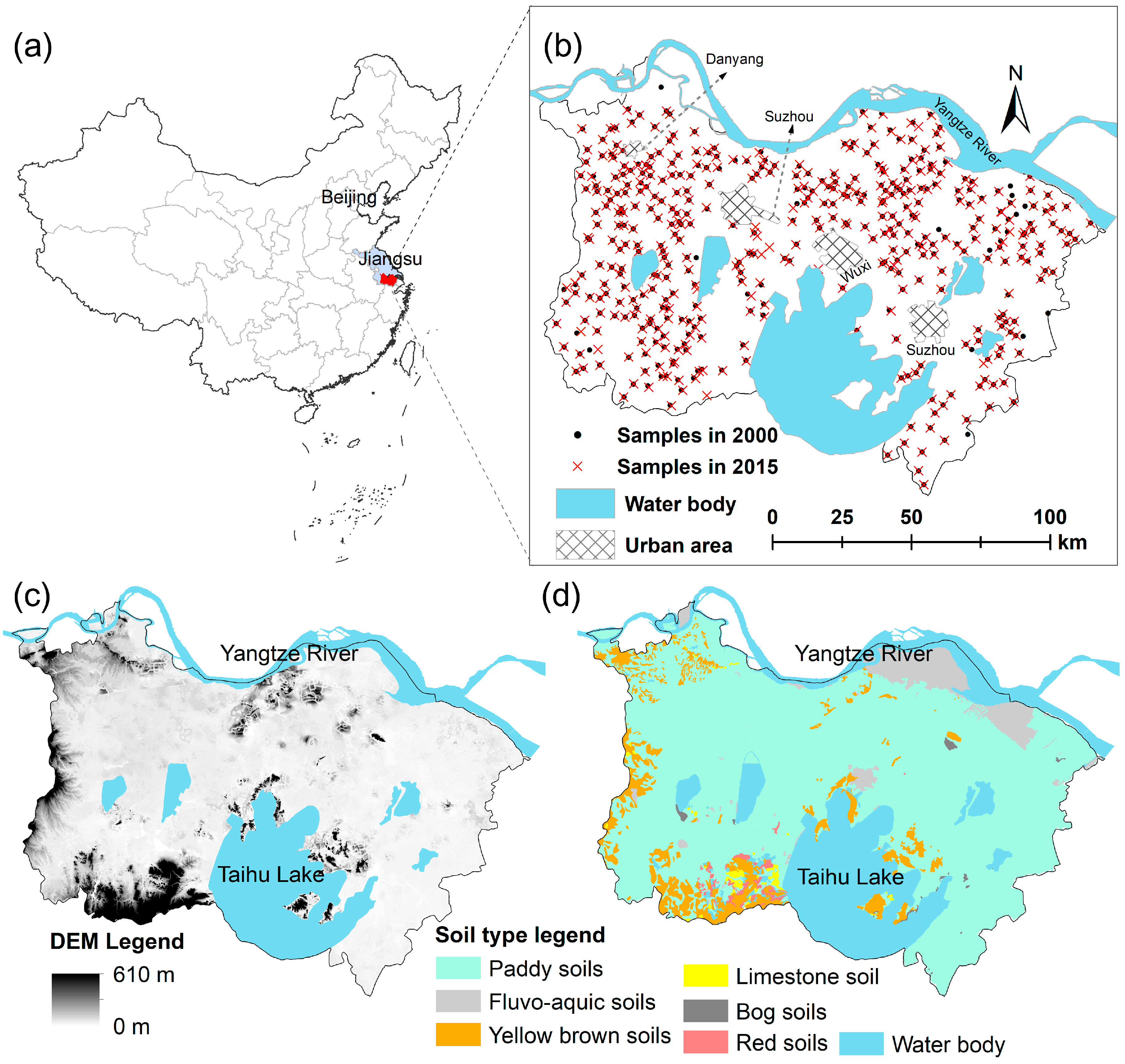
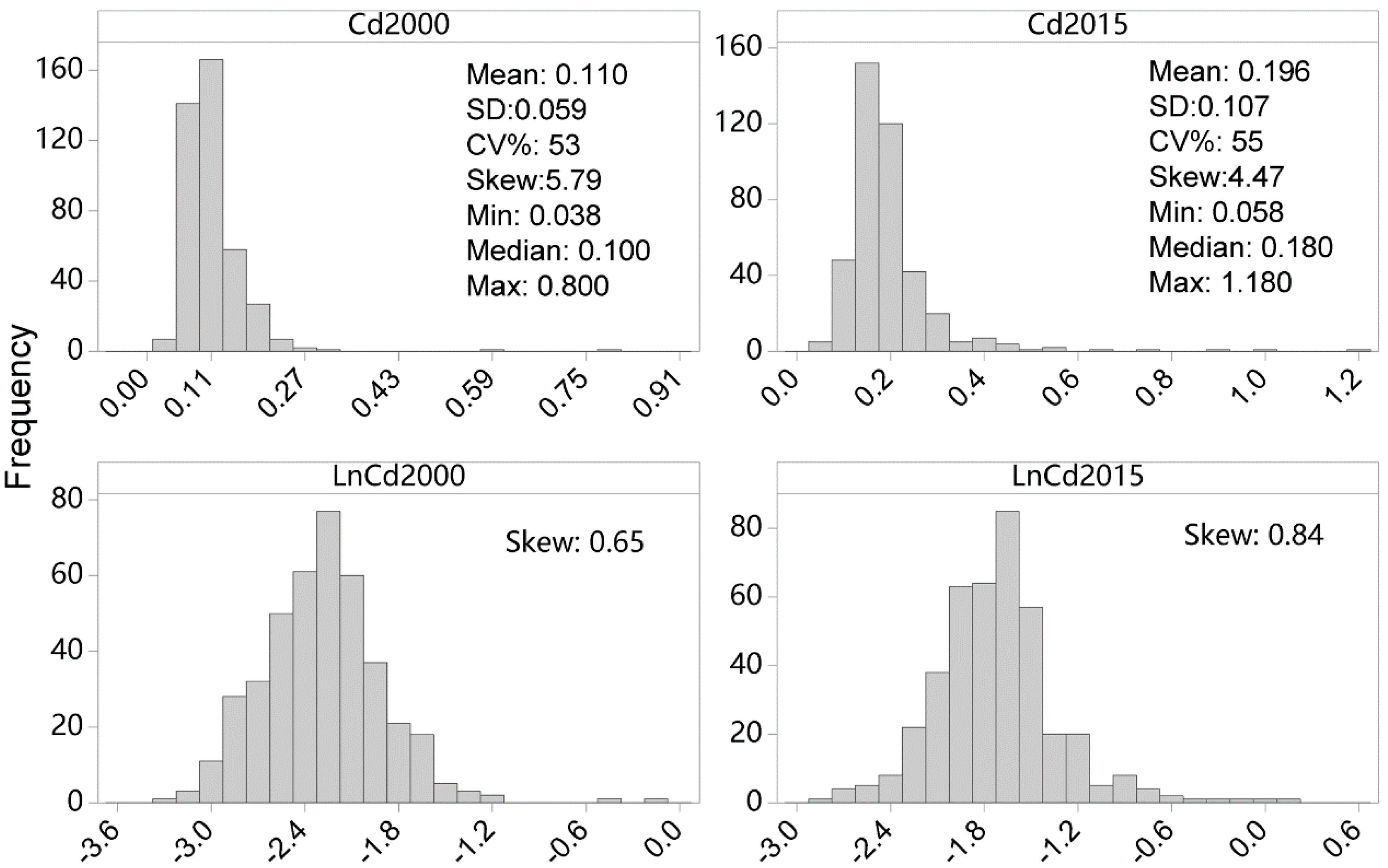
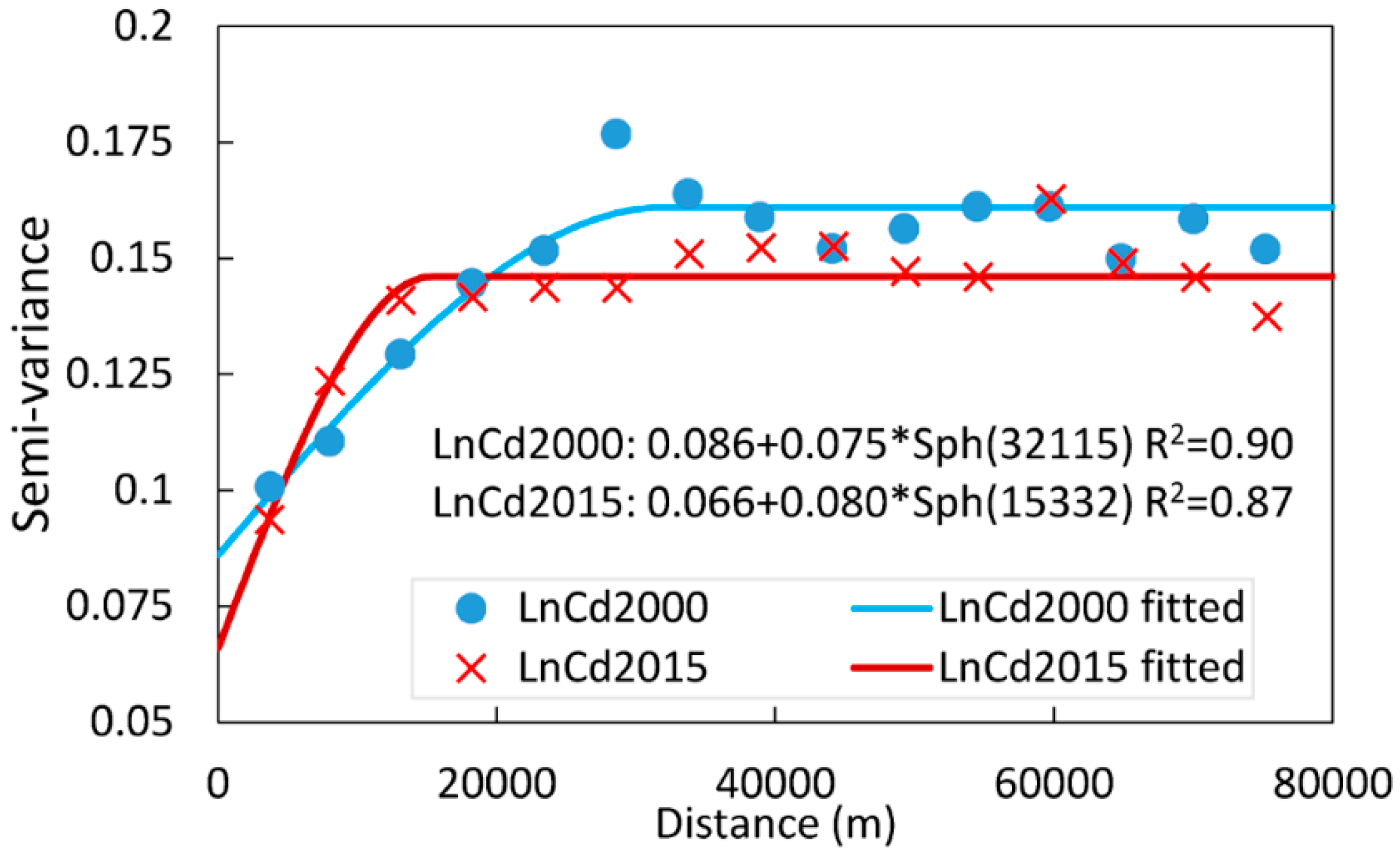
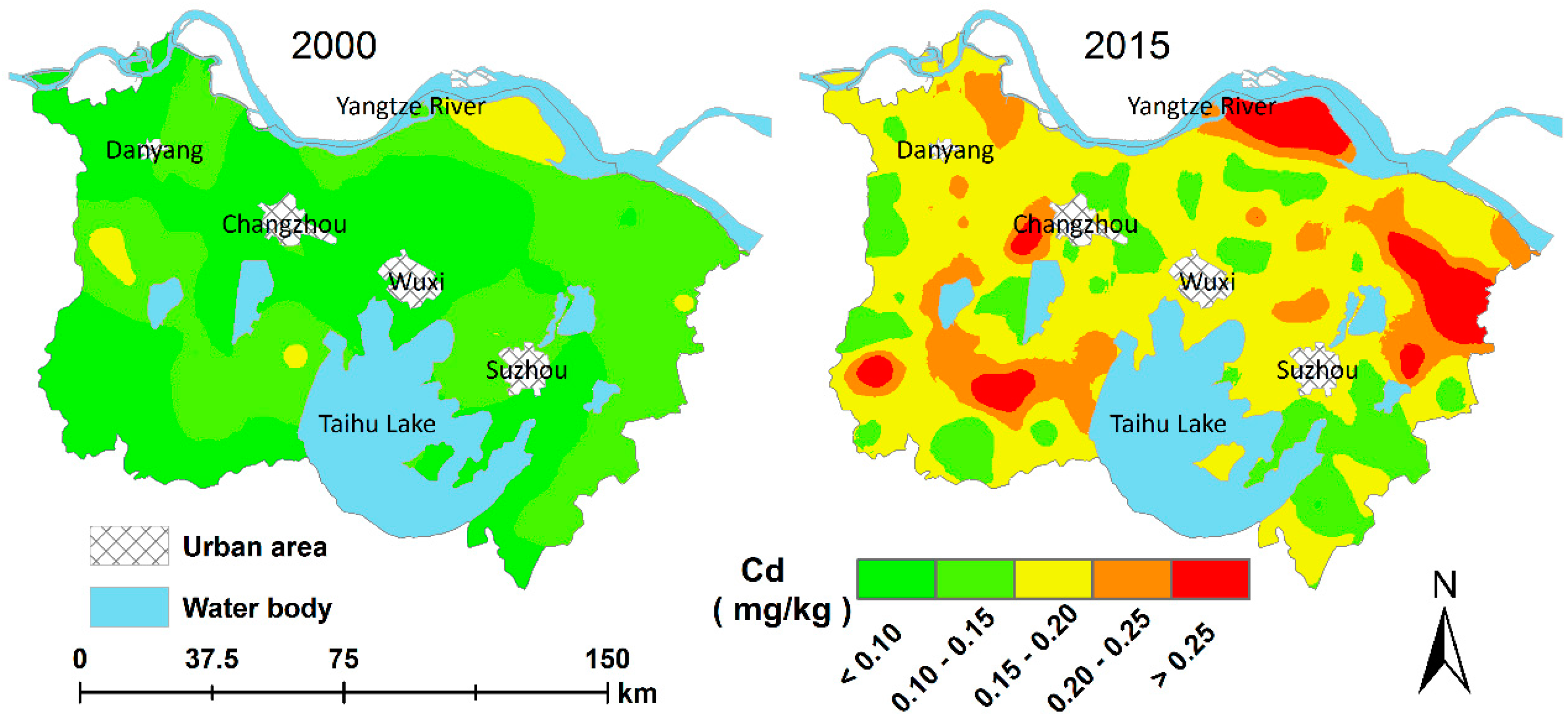



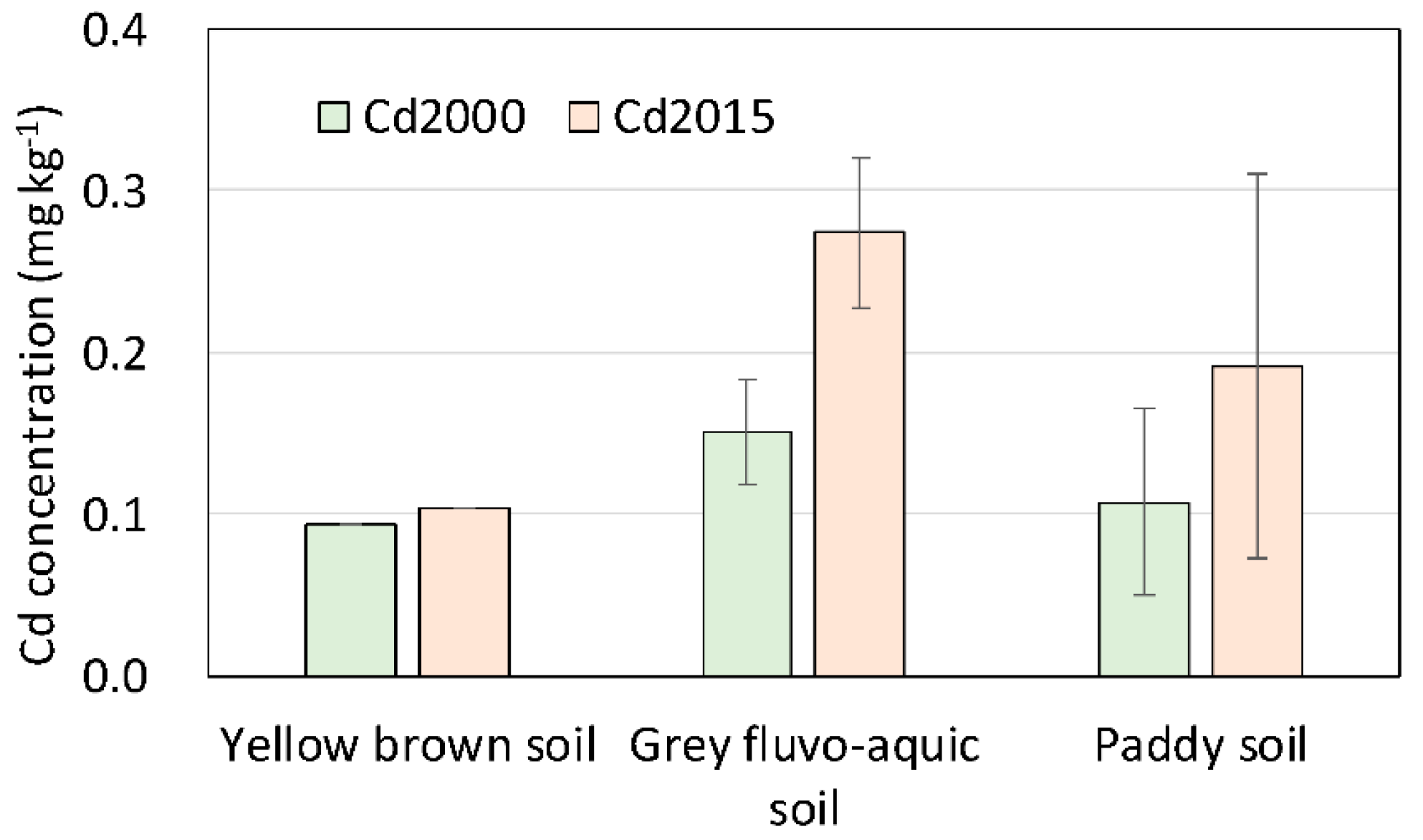

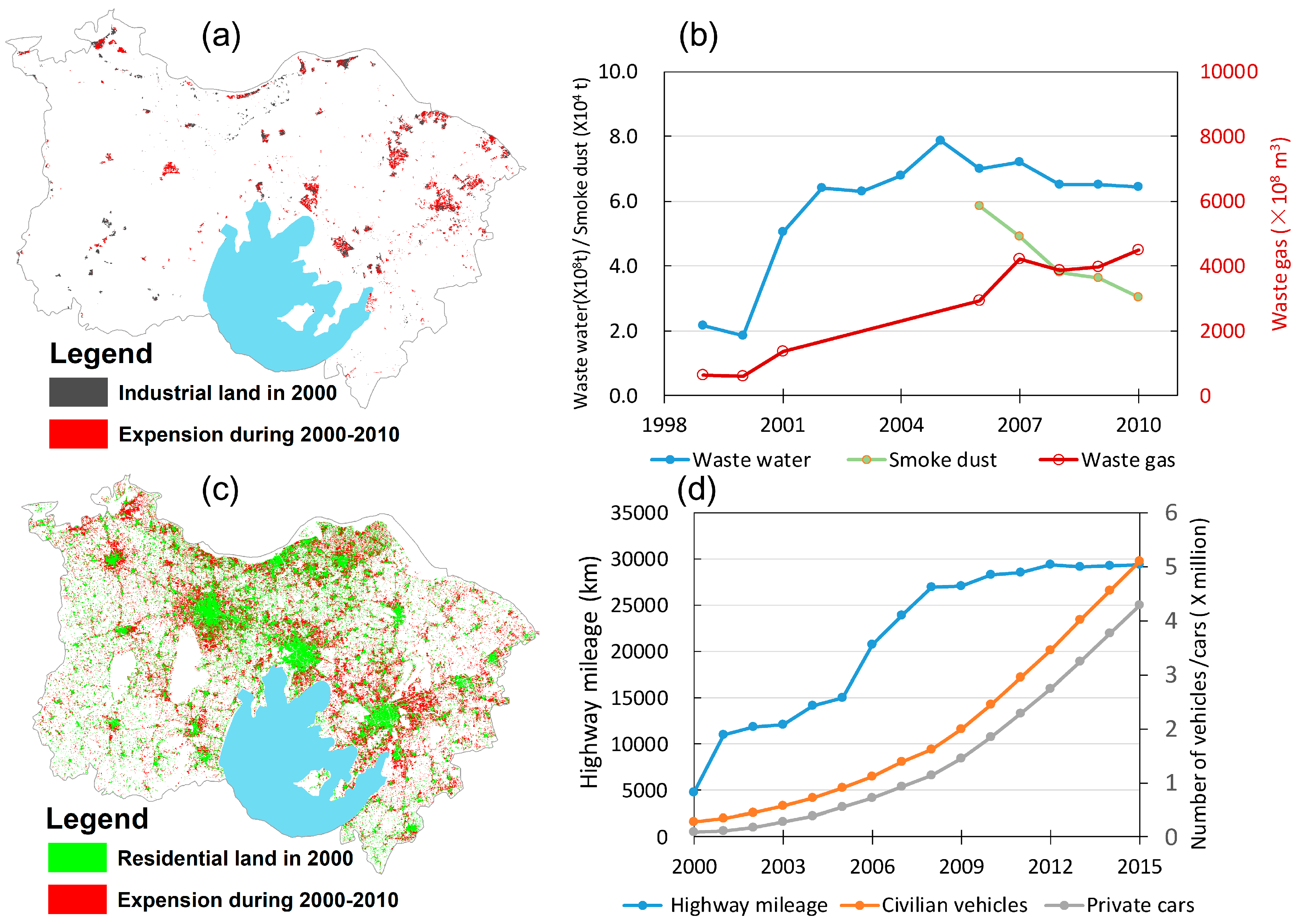
© 2018 by the authors. Licensee MDPI, Basel, Switzerland. This article is an open access article distributed under the terms and conditions of the Creative Commons Attribution (CC BY) license (http://creativecommons.org/licenses/by/4.0/).
Share and Cite
Xu, X.; Qian, J.; Xie, E.; Shi, X.; Zhao, Y. Spatio-Temporal Change and Pollution Risk of Agricultural Soil Cadmium in a Rapidly Industrializing Area in the Yangtze Delta Region of China. Int. J. Environ. Res. Public Health 2018, 15, 2743. https://doi.org/10.3390/ijerph15122743
Xu X, Qian J, Xie E, Shi X, Zhao Y. Spatio-Temporal Change and Pollution Risk of Agricultural Soil Cadmium in a Rapidly Industrializing Area in the Yangtze Delta Region of China. International Journal of Environmental Research and Public Health. 2018; 15(12):2743. https://doi.org/10.3390/ijerph15122743
Chicago/Turabian StyleXu, Xianghua, Jiaying Qian, Enze Xie, Xuezheng Shi, and Yongcun Zhao. 2018. "Spatio-Temporal Change and Pollution Risk of Agricultural Soil Cadmium in a Rapidly Industrializing Area in the Yangtze Delta Region of China" International Journal of Environmental Research and Public Health 15, no. 12: 2743. https://doi.org/10.3390/ijerph15122743
APA StyleXu, X., Qian, J., Xie, E., Shi, X., & Zhao, Y. (2018). Spatio-Temporal Change and Pollution Risk of Agricultural Soil Cadmium in a Rapidly Industrializing Area in the Yangtze Delta Region of China. International Journal of Environmental Research and Public Health, 15(12), 2743. https://doi.org/10.3390/ijerph15122743




